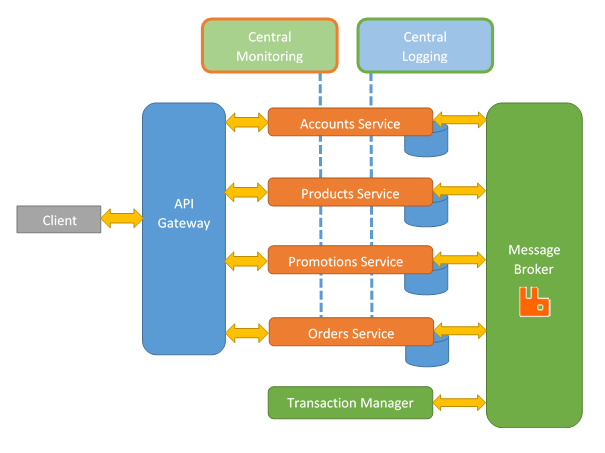Microservices: Brownfield: Migration: Database | Microservices: Brownfield: Reporting
When moving from a monolithic system to a micro-service architectured system, we need a different approach when dealing with transactions.
Transactions are useful:
- They ensure data integrity.
- They allow us to updates several records as part of one transaction.
- If one or more updates (and/or creates) fails, we can roll the entire transaction back.
In monolithic transactions are simple. We can have one process which is updating and creating records. These records are part of the transaction; therefore, the same process can either commit the transaction or roll it back if there are any issues.
In micro-services, transactions spanning are complex because there are several processes. This means that several micro-services are involved in complete one transaction. Since our transaction is distributed along multiple micro-services, it becomes a complex procedure to observe and solve problems; therefore, it becomes complex to roll back.
For example, we can have a order being place. This process will take several micro-services working together.

If one of these micro-services fails when trying to create or update a record, we will need to rollback the entire transaction.
How to handle fail transactions:
- Option 1: Try again later.
- The part of the transaction that failed is put into a queue so another service can pick it up and process.
- Transaction will eventually be completed.
- It relies on other instances not failing with the same part of transaction.
- The part of the transaction that failed is put into a queue so another service can pick it up and process.
- Option 2: Abort the entire transaction.
- We detect our transaction has failed, then we issue an Undo transaction to all the micro-services involved so they undo any creates or updates
- Problems:
- Who issue the undo transaction?
- What happens when the undo transaction fails itself.
- One way to overcome this problem is to use a transaction manager software.

- This software use a two phase commit.
- Phase 1: All micro-services involved indicates to the transaction manager if they are fine to commit to their part of the transaction.
- Phase 2: If they are fine to commit, then the transaction manager tells all participating micro-services to commit the transaction.
- If any of the micro-services doesn’t respond or responds with a “no to committing” then the transaction manager tells to all the participating micro-services to rollback the transaction.
- Problem using transaction manager?
- We are heavily dependent of it.
- It delays the processing of our transactions. Potential bottleneck.
- Complex to implement.
- More complex when we need to communicate with a monolithic system.
- This can be accomplish with the message queue.
- Problems:
- We detect our transaction has failed, then we issue an Undo transaction to all the micro-services involved so they undo any creates or updates
© 2017, Alejandro G. Carlstein Ramos Mejia. All rights reserved.
